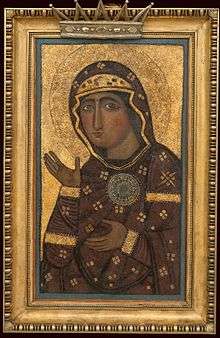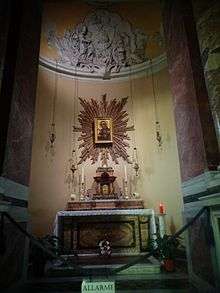Santi Bonifacio ed Alessio
The Basilica dei Santi Bonifacio e(d) Alessio is a basilica, rectory church served by the Somaschans, and titular church for a cardinal-priest on the Aventine Hill in the third prefecture of central Rome, Italy.
It is dedicated to Saint Boniface of Tarsus and (originally only) Saint Alexius. It lies on Piazza Sant’Alessio 23, near the historical gardens of St. Alexius and Via di santa Sabina.
Basilica


Founded between the 3rd and 4th centuries, it was restored in 1216 by Pope Honorius III (some columns of his building survive in the present building's eastern apse); in 1582; in the 1750s by Tommaso De Marchis (his main altar survives); and between 1852 and 1860 by the Somaschi, which congregation still serves it as a rectory church. The 16th century style facade, elaborated from the De Marchis phase, is built onto the medieval-style quadriportico.
The church has a Romanesque campanile. On the south side of the nave is the funerary monument Eleonora Boncompagni Borghese of 1693, to a design of Giovan Contini Batiste, and in the south transept the Chapel of Charles IV of Spain, with the icon Madonna di sant'Alessio, an Edessa icon of the Intercession of the Madonna dating from the 12-13th centuries, thought to have been painted by St Luke the Evangelist and brought from the East by St Alexius. The church also contains the tombstone of Peter Savelli (of the same family as Pope Honorius III).
In a Romanesque crypt that survives below the church, the main altar contains relics of St Thomas of Canterbury. The crypt's 12th-century wall of frescoes depicts the Agnus Dei and symbols of the Four Evangelists, and on the north aisle St Gerolamo Emiliani introducing orphans to the Virgin by Jean Francois De Troy, and at the end of the aisle The Holy Steps and the titular church of Saint Alexius in wood and stucco by Andrea Bergondi.
Connected to the basilica are the buildings of the former monastery, which now belong to the Italian state.
In 2015[1] and again on June 29 2019, it was noticed by the Italian press the discovery of a Middle Age fresco in an exceptional state of preservation and integrity. The painting has been restored and its subject has been identified by the Italian art historian Claudia Viggiani with Christ the Pilgrim.[2][3][4][5] The fresco was firstly discovered in 1965 by the Italian Genio Civile during the stabilization's works of the bell tower, and then discarded for forty years, until 2005.
Burials
Cardinal title
The basilica has been a titular church for Cardinal-priests (the second order) from 1587, originally called Sant'Alessio.
In the 19th century, the former dedication of the basilica was renewed, and from that time on the official name of the basilica and the cardinal titulus are Santi Bonifacio e(d) Alessio.
Cardinal-protectors
(all Roman Rite, Cardinal-Priests and Italian unless otherwise mentioned)
- Giovanni Vincenzo Gonzaga (1587–1591)
- Ottavio Paravicini (1592–1611)
- Metello Bichi (1611–1619)
- Roberto Ubaldini (1621–1629)
- Giovanni Francesco Guidi di Bagno (1629–1641)
- Mario Theodoli (1641–1649)
- Luigi Omodei (1652–1676)
- vacant (1676–1681)
- Federico Visconti (1681–1693)
- Taddeo Luigi del Verme (1696–1717)
- Gilberto Borromeo (1717–1740)
- Gaetano Stampa (1740–1742)
- vacant (1742–1753)
- Antonio Andrea Galli (1753–1757)
- Giuseppe Maria Castelli (1759–1780)
- Paolo Francesco Antamori (1781–1795)
- vacant (1795–1801)
- Giovanni Filippo Gallarati Scotti (1801–1814)
- Emmanuele de Gregorio (1816–1829); in commendam (1829–1839)
- vacant (1839–1843)
- Francesco di Paola Villadecani (1843–1861)
- (French) Alexis Billiet (1862–1873)
- (Austrian) Johannes Baptist Franzelin, Jesuit (S.J.) (1876–1886)
- Giuseppe d' Annibale (1889–1892)
- Angelo Di Pietro (1893–1903)
- (Spanish) Sebastián Herrero y Espinosa de los Monteros, C.O. (1903)
- (Brazilian) Joaquim Arcoverde de Albuquerque Cavalcanti (1905–1930)
- (Brazilian) Sebastião Leme da Silveira Cintra (1933–1942)
- (Brazilian) Jaime de Barros Câmara (1946–1971)
- (Brazilian) Avelar Brandão Vilela (1973–1986)
- (Brazilian) Lucas Moreira Neves, Dominican Order (O.P.) (1988–1998); in commendam (1998–2002)
- (Brazilian) Eusébio Oscar Scheid, Dehonian (S.C.J.) (2003–)
References
- Giulia Ronchi (Jul 1, 2019). ""Exceptional" finding in Saint Alessio, Rome. But it was known by years ago" (in Italian). Archived from the original on Jul 7, 2019.
- "Fresh Light Illuminates Brilliant Medieval Fresco Incarcerated For Centuries in Rome". ancient-origins.net. Jul 3, 2019. Archived from the original on Jul 3, 2019 – via ANSA video.
- "Middle Age fresco discovered after 900 years". lsussidiario.net (in Italian). Rome. Jun 29, 2019. Archived from the original on Jun 30, 2019.
- "Rome: discovered an exceptional Middle Age fresco". TG5 (in Italian). Jun 29, 2019. Archived from the original on Jun 30, 2019.
- "Rome, found an untouched fresco of the Middle Age period". Corriere della Sera. Rome. Jun 29, 2019. Archived from the original on Jul 7, 2019.
External links
| Wikimedia Commons has media related to Santi Alessio e Bonifacio. |
